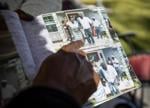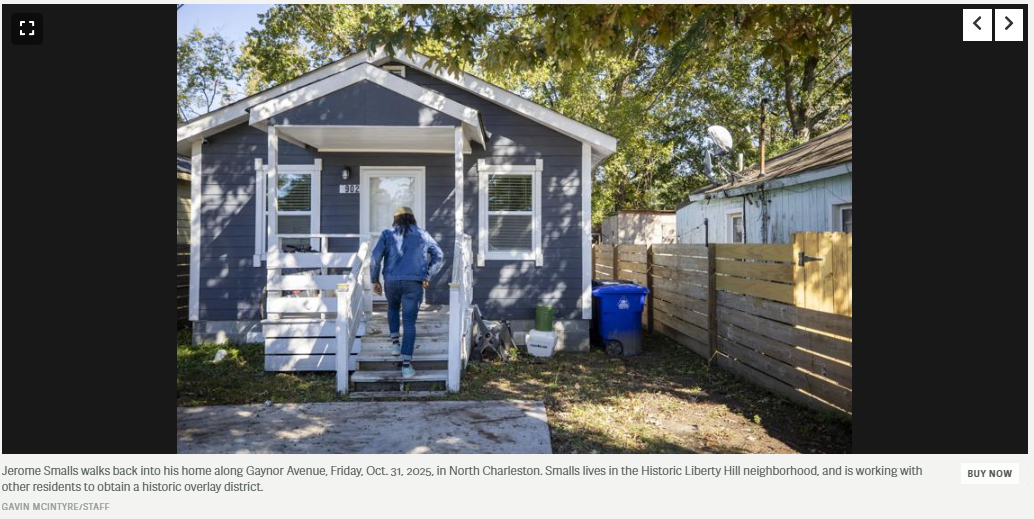SOUTH CAROLINA: North Charleston Community Seeks to Protect HIstoric Roots
NORTH CHARLESTON — For lifelong resident Kerry Gambrell, Liberty Hill has always been home.
Gambrell, now in his 60s, grew up on Hassell Street, once the neighborhood’s hub with a community center, basketball court, swimming pool and large park area. Many of those amenities remain but they no longer serve as the gathering space, he said. His childhood home no longer exists either.
He remembered when Liberty Hill had three nightclubs and a few restaurants, places for folks to unwind after work to shoot pool and crank up the jukebox. For an authentic soul food dinner, Al’s Diner on East Montague Avenue was the place to go.
“You didn’t have to go nowhere,” he said. “I mean, you buy your groceries, you can wash your clothes, you can go to the ice cream parlor, you can go the club, you can hang out.”
The city’s oldest surviving community, Liberty Hill’sAll Posts roots date to 1871 when four men purchased 112 acres to create a community where Black families could thrive after the Civil War. Once home to mom and pop shops, pharmacies and a grocery store, the self-sustaining neighborhood declined after the nearby Navy Base closed in the 1990s and a lack of investment followed.

Kerry Gambrell (left) holds a photo of himself as a child with his siblings as his wife, Latrisha Gambrell, holds a wedding photo of her in-laws at their home, Friday, Oct. 31, 2025, in North Charleston. Kerry Gambrell is a lifelong resident of the Historic Liberty Hill neighborhood and wants the neighborhood to bring back the amenities he had as a child.
Today, roughly 200 lots sit vacant.
The historic neighborhood today is in the heart of some of the city’s largest development projects. But residents are becoming more persistent in their efforts to preserve Liberty Hill’s character as developers eye the area.
“When we think about the marginalization of historically Black neighborhood, I think Liberty Hill is the epitome of that,” said resident Jerome Smalls.
Stretching along East Montague Avenue between Gaynor and Mixon avenues, the neighborhood is minutes from Park Circle’s bustling dining and shopping district, and about a mile from the $1 billion Roper St. Francis medical campus under construction near Interstate 26.
With nearby growth on the horizon, neighborhood leaders are pursuing a special city zoning overlay that would guide new construction and renovations so homes match Liberty Hill’s traditional single-family cottages and shotgun houses.
“The best route is going through the city and getting an overlay put in place,” said Madison Lee, the community outreach coordinator with The Preservation Society of Charleston.
Honoring the past
While businesses have shuttered, some aspects reminiscent of the old Liberty Hill still exist, like the community spirit.
Kerry and his wife Latricia got married on their front lawn a few years ago. Latricia said the wedding was like a neighborhood block party.
“The whole community came out,” she said. “It was really beautiful.”

Latrisha Gambrell shows a photo of her and her husband, Kerry Gambrell, taking a leap on their wedding day at their home, Friday, Oct. 31, 2025, in North Charleston. The Gambrells were married outside their home in front of family and friends.
Latricia, who once hesitated to move there, said she’s found a deep sense of belonging. They walk to church and ride their bikes on the residential streets. They know their neighbors and enjoy quiet nights sitting on their porch.
They’ve also watched what’s changed. They’ve spoken against developers seeking zoning changes that would allow for higher density housing, like an apartment complex. Kerry said he supports the historic zoning overlay to keep the neighborhood’s character intact.
Condida Deas Joy, vice president of the Liberty Hill Historical and Genealogical Society and descendant of founder Ishmael Grant, said said she wants the area to flourish again, but with its history honored.
“Liberty Hill will always be my home, but Liberty Hill has changed a whole lot,” she said.
Protecting the historic neighborhood
On Lester Street, two new three-story homes tower over a small cottage built by the Charity Foundation, said Smalls, who is on the board of the Liberty Hill Improvement Council. He said this contrast is why the overlay is needed.
“We want new homes,” he said. “We just want them to look and feel like the neighborhood.”
Without protection from the city, not much can be done to control what is built.
Tim Macholl, the city’s planning and zoning director, spoke to residents about the historic zoning overlay district at the neighborhood meeting in October. The overlay would give special guidance to preserve, protect and mitigate negative changes or demolitions. It’s up to the community as to what these guidelines will look like.

Two new homes are built side by side in the Historic Liberty Hill neighborhood, Friday, Oct. 31, 2025, in North Charleston. Liberty Hill residents are worried about developers building properties that aren’t in keeping with the character of the neighborhood.
“The intent is not to freeze a neighborhood in time, but to help manage changes so that the new development is sensitive to the history and character of that area,” he said.
The city has had this type of zoning in a part of Park Circle called Olde North Charleston since 2008. New construction there must meet design guidelines reviewed by the city’s Planning and Zoning department.
Valerie Harper Young, the president of the Liberty Hill Improvement Council, said the group has worked for years to secure this type of protection, renewing efforts last year. After submitting the application in May, they’ve gone back and forth with the city over requests for additional information, she said.
“We’re not clear on the next steps,” she said.
Once the final draft is completed, Macholl said it will take three months to go through the city council process for approval.
A vision for the future
Smalls, 28, bought his home in Liberty Hill in 2023 after moving from Washington, D.C. He grew up on Dorchester Road and returned to his hometown after seeing the rapid development across the Charleston area. He wanted to help preserve neighborhoods like Liberty Hill.
Though he grew up nearby, Smalls said he didn’t know much about the history of Liberty Hill until moving back as an adult. Now, he’s actively involved in community efforts to revitalize the neighborhood while protecting its history.

Jerome Smalls stands in his front yard along Gaynor Avenue while discussing how he bought his home, Friday, Oct. 31, 2025, in North Charleston. Smalls lives in the Historic Liberty Hill neighborhood, and is working with other residents to obtain a historic overlay district.
He hopes more first-time homebuyers like himself invest in the neighborhood, but that’s only possible if the homes stay affordable, he said.
“That’s really an opportunity for Liberty Hill to provide an opportunity for young professionals to help revitalize this neighborhood because there isn’t a lot of young people here,” he said.
His home, built in 2021 by a local builder and Liberty Hill native Trojan Bell, reflects the balance. Though new, its cottage-style design matches the older homes on his street. It’s the kind of development residents say they want: modest, affordable and true to the neighborhood’s character.
“All we’re asking is to preserve this small piece of real estate that has so much history, and that can be a hub and a beacon of affordability even in the midst of all of this economic prosperity happening all around it,” he said.
–postandcourier.com



